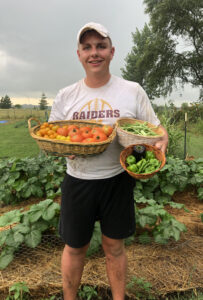
We regularly feature geography related student internships on this blog. Today we hear from James Miller (‘21), a double major in Geography and Biology, who participated in a GIS internship for Nicollet County, MN, this summer.
Describe the internship you participated in this summer.
I spent ten hours a week working with Nicollet County Property and Services where I contributed to a Geographic Information Systems (GIS) hazardous waste and recycling management project that serves residents in Nicollet, LeSueur, and Sibley counties. Using the online tool, you can search a wide range of disposal materials, from “pizza box” to “paint cans” and the tool connects you to a map with appropriate disposal sites nearby. In an effort to encourage mindful recycling behavior, the online tool allows residents to properly dispose of hazardous waste and environmental contaminants. I worked to update existing information in GIS to make it far more comprehensive and spent my time getting the tool ready for its county-wide launch.
What did you enjoy the most about the experience?
When I was in high school I had the opportunity to participate in some city government initiatives and served on a board for three years, so it was really great to get back into local level work again. All of the people I worked with were very accommodating, welcoming, and appreciative of my work, and I was really happy to be able to contribute to a project that was meaningful both for the department and for residents living in the area.
How do you feel your internship related to things you’ve learned in class?
This internship had direct ties to GIS coursework, and I could not have pursued this opportunity if I hadn’t gained an understanding of the software in class. While this was the most immediately obvious connection between the internship and class, the critical thinking, problem solving, and collaborative teamwork skills that I used in this internship also have ties to a handful of courses that have modeled these things.
What was the hardest part of your internship?
I think the hardest part was coming in at a midway point in this project and trying to understand what exactly had been done and what specific expectations were moving forward. Since the project was not something that I personally started, there was a little bit of a lag time in substantial progress. It took a little bit for me to get into the groove of things, but I think that comes with any new job position.
What skills do you feel you gained from this experience?
I worked quite independently in my role, and throughout the process, I felt myself gaining a sense of confidence in my skills and abilities to perform. While I knew I had a solid understanding of GIS, being able to solve problems without the help of an instructor or peer was really empowering and makes me excited to continue to learn more in the second GIS course!
Is there anything else you would like us to know?
This internship didn’t follow the typical application format and was actually somewhat of a self-initiated thing. After learning about their work through local news articles, I reached out to members of the department through email expressing my interest in what they were doing and asked whether or not they would be interested in receiving additional help over the summer. A few days later, I had a conversation with members in leadership roles, and we thought it would be a good match. Regardless of the fact that it might feel a little bit awkward to put your name out there, especially when a formal application does not exist, I think it is really valuable to embrace a mindset that pushes to reach out because the worst thing that can happen is that you get told no.
Leave a Reply